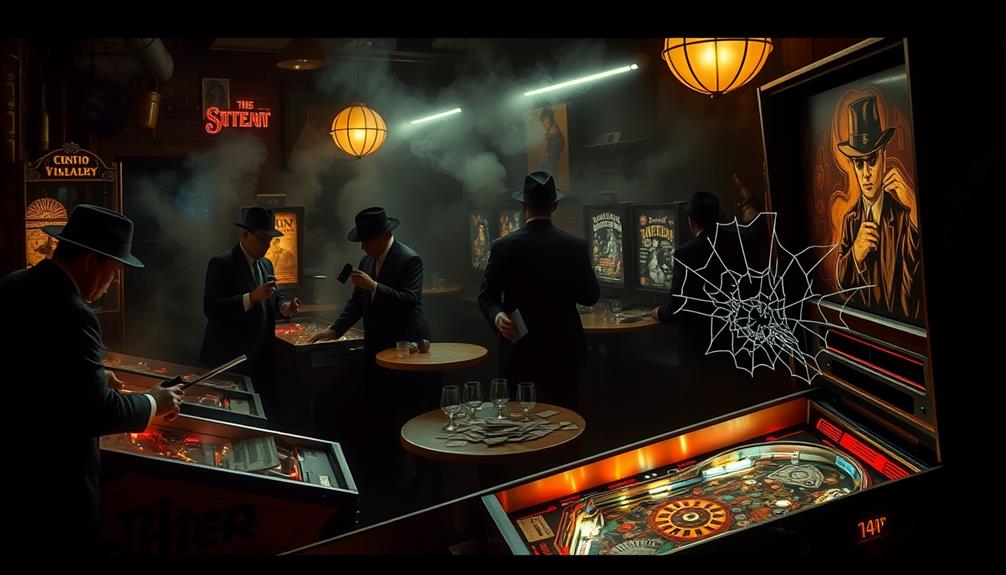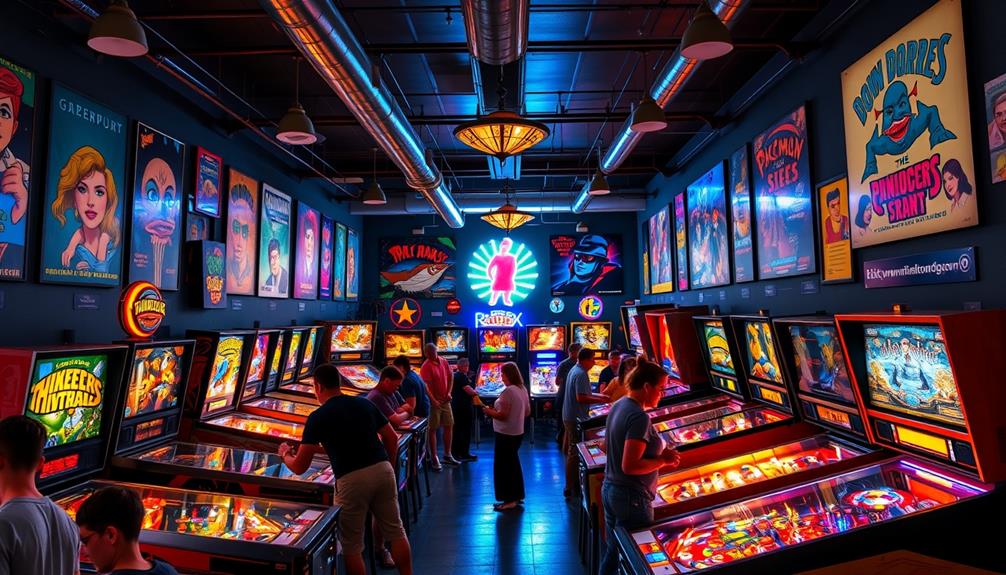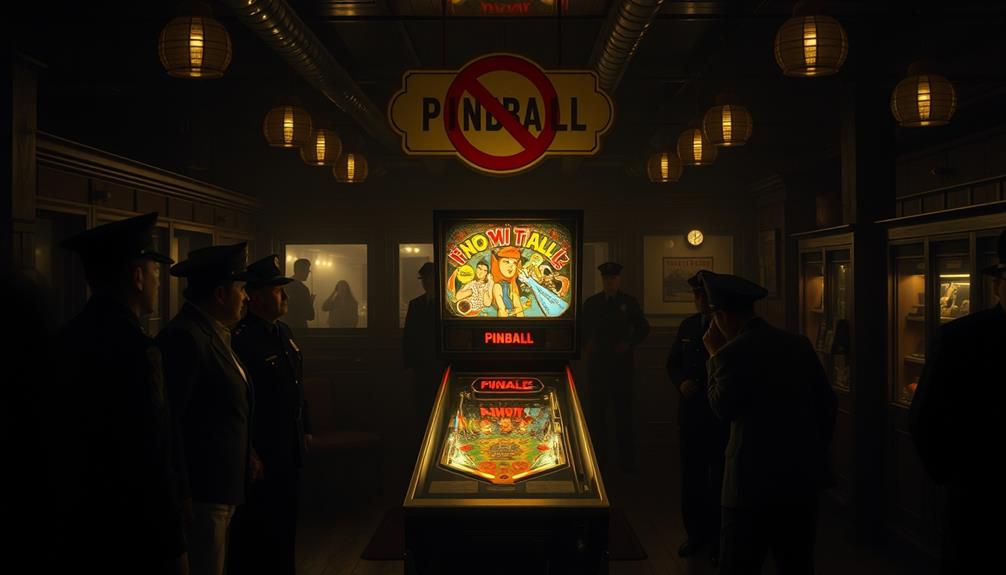Pinball was prohibited in the 1930s mainly due to its association with gambling and youth delinquency. Local authorities, such as Mayor Fiorello La Guardia, believed that these machines attracted young people to gambling, endangering their futures. Many cities enforced strict laws, conducting raids to seize and destroy thousands of machines. The media further fueled fear among the public, painting pinball as a corrupting influence. As a result of these pressures, pinball became stigmatized and driven underground as a perceived societal threat. If you’re interested in learning more about how these perceptions evolved over time, there is much to explore. One of the most intriguing aspects of the history of pinball prohibition is the eventual shift in public opinion. Over the years, people began to view pinball differently, recognizing it as a harmless form of entertainment. In the 1970s, after years of being banned, pinball machines began to resurface in public places, marking a turning point in the game’s perception. The history of pinball prohibition is a captivating example of how societal attitudes can change over time. Today, pinball is enjoyed by individuals of all ages and is even considered a nostalgic and retro pastime. The history of pinball bans is a reminder of how cultural perceptions and fears can influence public policy and societal attitudes. Despite its turbulent past, pinball has persevered and thrived, demonstrating that even activities with stigma can find redemption in the eyes of society. This history also emphasizes the importance of persistence and advocacy in challenging and overturning unjust laws and biases.
Key Takeaways
- Pinball machines were viewed as gambling devices, leading to fears of financial exploitation and youth addiction.
- Mayor Fiorello La Guardia led campaigns against pinball, framing it as a mob-controlled gambling racket.
- Numerous U.S. cities enacted bans in the 1930s due to concerns over juvenile delinquency and organized crime associations.
- Public outcry and sensational media portrayals linked pinball to societal moral decline, amplifying fears of its influence on youth.
- Confiscation and destruction of machines by law enforcement reinforced negative perceptions and stigmatization surrounding pinball.
Historical Context of Pinball
In the bustling arcades of the 1930s, pinball machines quickly became the center of attention, yet they were mired in controversy. These machines, often seen as games of chance rather than skill, sparked heated debates about gambling and morality.
As pinball gained popularity, concerns over youth gambling and delinquency intensified, mirroring the concerns seen in other areas related to emotional dysregulation and impulsivity, similar to those observed in individuals with Borderline Personality Disorder. Many cities across the U.S. began enacting bans, fearing that these vibrant machines were luring young people into a world of vice.
New York City, under the leadership of Mayor Fiorello La Guardia, was at the forefront of this crusade. La Guardia and others characterized pinball as a mob-controlled gambling racket, exploiting the vulnerable and leading youth astray.
The Bally Hoo, the first coin-operated pinball machine, exemplified this conflict; despite its popularity, its random ball movement reinforced the perception of gambling.
As the 1930s progressed, the push for prohibition grew stronger, ultimately leading to a widespread legal crackdown on pinball machines. By the end of the decade, cities like New York had implemented bans, marking a significant shift in the perception of these once-celebrated games.
Legal Bans and Enforcement

In the 1930s, you'd see cities cracking down on pinball due to its gambling associations and concerns over youth exploitation.
The push for legal bans was also influenced by broader societal fears regarding the impact of gambling on public health and safety. Government officials, like Mayor LaGuardia, took action, enforcing bans with police raids that confiscated and destroyed machines.
As these legal measures spread, pinball games were pushed underground, marking a significant shift in how society viewed this once-popular pastime.
Common types of cold medications were often a topic of discussion in the context of recreational activities during this era.
Gambling Associations and Concerns
The rise of pinball machines in the 1930s sparked significant concern among gambling associations and lawmakers, who viewed these coin-operated devices as tools for gambling. Many believed they posed a threat to youth, leading to calls for a ban. Concerns about the machines' impact on financial health and their potential to lead to overspending were prevalent, prompting further scrutiny.
In 1937, the Illinois Attorney General took action, citing the machines' connection to financial exploitation. New York City followed suit in 1942, with Mayor Fiorello LaGuardia condemning pinball as a "mob-controlled gambling racket" that preyed on vulnerable citizens.
Public sentiment turned sharply against pinball as sensational media campaigns linked the machines to organized crime and juvenile delinquency. This fueled a moral imperative to act, prompting enforcement measures like police raids. Authorities confiscated machines and even destroyed them publicly, framing these actions as necessary to protect the community from the ills of gambling.
The perception that pinball machines encouraged gambling and exploited youth solidified the movement against them. As a result, bans proliferated, reflecting the widespread concern over the potential dangers these games posed to society.
Government Crackdown and Enforcement
Numerous cities across the United States took decisive action against pinball machines during the 1930s, implementing legal bans fueled by the perception that these games were merely sophisticated gambling devices.
In 1937, the Illinois Attorney General outlawed pinball, citing concerns about its gambling implications and ties to organized crime. The crackdown intensified when New York City Mayor Fiorello LaGuardia led a moral campaign in 1942, resulting in the confiscation of over 2,000 machines. This crackdown mirrored the attitudes seen in precious metal investments, where concerns about exploitation and financial risk necessitated strict regulations and oversight.
Enforcement measures rolled out swiftly across the nation, aiming to eliminate the perceived threat of pinball.
- Police raids targeted establishments with machines.
- Public destruction of confiscated pinball devices created a spectacle.
- Hefty fines were imposed on those violating the bans.
- Other cities quickly adopted similar laws and enforcement strategies.
- The stigma surrounding pinball lingered, framing it as a tool for exploitation, especially among youth.
With these actions, authorities sought to combat gambling and protect vulnerable citizens, cementing pinball's status as a banned activity in many communities.
The legacy of this crackdown shaped the perception of pinball for decades to come.
Public Perception and Stigmatization

In the 1930s, you'd see pinball machines as more than just games; they sparked moral panic over gambling and youth delinquency.
Critics painted a picture of pinball as a dangerous influence, often fueled by sensational media stories linking it to organized crime.
This heightened stigma not only shaped public opinion but also pushed authorities to take drastic action against the machines.
Moral Panic Over Gambling
During the 1930s, pinball machines became a focal point in a broader moral panic surrounding gambling and youth behavior. Many viewed pinball as a game of chance, linking it to organized crime and juvenile delinquency. This perception fueled a significant public outcry, with civic leaders and media sensationalism portraying pinball as a threat to community values.
The situation was exacerbated by concerns about the impact of gambling on interpersonal relationships, as many argued that it exploited vulnerabilities, similar to findings from the 16PF questionnaire which highlights the importance of understanding personality traits in evaluating behavioral influences.
- Pinball linked to organized crime and money laundering
- Perceived as a corrupting influence on youth
- Mayor Fiorello LaGuardia spearheading anti-pinball campaigns
- Staged destruction of machines as a public spectacle
- Framed as a moral necessity during World War II
Authorities, led by LaGuardia, claimed these machines exploited vulnerable citizens financially, reinforcing the stigma around pinball. The narrative that pinball was a mob-controlled gambling racket contributed to growing fears.
As a result, the ban on pinball emerged, seen as a necessary step to protect society from the perceived vices associated with gambling. The widespread belief that pinball machines contributed to moral decline reflected the anxieties of the era, ultimately leading to their prohibition and shaping public attitudes for years to come.
Youth Delinquency Concerns
Pinball machines quickly became scapegoats for concerns about youth delinquency in the 1930s, as critics argued they lured young people into gambling and away from their studies. Authorities viewed pinball as more than just a game; they associated it with organized crime, suggesting it preyed on vulnerable youth and exploited them financially.
The idea that pinball could lead to gambling addiction stirred public concern, amplifying fears about societal issues related to youth behavior. This sentiment can be likened to the way trust issues with boyfriends can arise from perceived harmful influences in relationships.
Civic groups, churches, and law enforcement joined forces to underscore the perceived dangers of pinball, pushing for bans in multiple cities. This collective effort fed into a growing negative sentiment against the game, painting it as a corrupting influence on the younger generation.
As pinball became synonymous with juvenile delinquency, those who played or supported it faced stigma. These bans reflected a broader anxiety about the impact of gambling-related activities on youth.
The perception that pinball was a gateway to delinquency solidified its status as a target for prohibition, revealing how societal fears can lead to sweeping measures against even innocent pastimes.
Media Sensationalism Effects
Media sensationalism played an essential role in shaping public perception of pinball machines during the 1940s. The media painted pinball as a corrupting force, primarily targeting youth and linking it to gambling and crime. This relentless portrayal intensified public fear and stigma around the game, making it a prime target for legislative bans. Reports often highlighted how the creative spark of young people was being stifled by these machines, framing pinball machines as tools of gambling rather than as a form of artistic expression.
- Pinball machines framed as tools of gambling
- Reports connecting pinball to juvenile delinquency
- Media narratives amplifying organized crime associations
- Public campaigns highlighting pinball's perceived corruption
- Staged destruction of pinball machines for media coverage
New York City Mayor Fiorello LaGuardia seized on this sensationalism, claiming pinball was part of a mob-controlled gambling racket. His statements, bolstered by media coverage, swayed public opinion considerably.
The negative portrayal in newspapers and civic discussions didn't just create fear; it influenced legislation that led to widespread bans. The public destruction of confiscated machines further solidified the belief that pinball posed a serious societal threat.
Ultimately, this media-driven narrative transformed pinball from a popular pastime into a stigmatized symbol of crime and corruption, paving the way for its prohibition.
Pinball's Association With Gambling

In the 1930s, pinball machines quickly became synonymous with gambling, largely due to their design and the way they were perceived by the public. Many viewed these machines as games of chance rather than skill, especially since early pinball lacked flippers, which meant players had limited control over the outcome. This perception fueled widespread concerns and led to significant bans on pinball in various cities.
| Aspect | Details |
|---|---|
| Game Type | Chance over Skill |
| Public Perception | Seen as gambling |
| Key Figure | Mayor Fiorello La Guardia |
| Illegal Activities | Linked to organized crime and rackets |
Critics argued that pinball machines exploited vulnerable citizens financially, leading to public outcry. As authorities linked these machines to illegal activities and money laundering, the association with organized crime deepened. Mayor Fiorello La Guardia's characterization of pinball as a mob-controlled racket solidified the negative view, resulting in legal prohibitions against its operation. This environment of fear and suspicion ultimately led to the widespread banning of pinball in New York City and beyond.
Impact of Organized Crime

The connection between organized crime and pinball machines during the 1930s created a significant impact on the public's perception of the game. As pinball became synonymous with illegal gambling, it drew the attention of law enforcement and sparked widespread public concern. The association of pinball with organized crime led to fears of corruption and juvenile delinquency, fueling political campaigns aimed at enforcing bans.
Pinball machines served as fronts for illegal gambling operations.
Mobsters exploited the popularity of pinball for money laundering.
Law enforcement testimonies highlighted pinball's role in organized crime.
Authorities viewed pinball as a moral threat to society.
Major cities like New York and Chicago enacted bans on pinball machines.
These factors collectively reinforced the belief that pinball was a dangerous influence. The perception that it contributed to juvenile delinquency and corruption prompted city officials to act decisively.
Ultimately, these views led to the widespread banning of pinball machines, as communities sought to eliminate what they believed were harmful elements in their neighborhoods. This drastic response illustrated how deeply organized crime affected the reputation and future of pinball during that era.
Changes in Attitudes in the 1970s

As the 1930s' fears of pinball's connection to organized crime faded, attitudes began to shift dramatically in the 1970s. A pivotal moment occurred when the California Supreme Court ruled that pinball was a game of skill, marking a significant turn toward legalization.
This decision inspired cities, including New York, to reconsider their longstanding ban on pinball machines. In 1976, amid a financial crisis, the New York City Council weighed the potential for licensing revenue, estimated at $1.5 million, which further fueled the discussion.
The changing landscape of societal values mirrored the evolving perceptions of other areas, such as the emerging importance of AI ethics in technology.
Roger Sharpe, a top pinball player, played a vital role in this transformation. He demonstrated the skill involved in pinball during a council meeting, effectively swaying opinions and helping to overturn the ban in New York City.
This shift didn't stop there; cities like Chicago also began relaxing their restrictions on pinball machines by the late 1970s. The change in perception transformed pinball from a symbol of vice and illegal gambling into a recognized form of entertainment and a legitimate pastime, reflecting society's evolving views on leisure and skill-based games.
Frequently Asked Questions
Why Did NYC Ban Pinball?
New York City banned pinball due to concerns about gambling, juvenile delinquency, and organized crime influence. Mayor LaGuardia viewed it as a threat to public morality, leading to a significant crackdown on machines throughout the city.
When Did Pinball Get Unbanned?
You'll find that pinball's return to favor began in 1974 when the California Supreme Court recognized its skillful nature. By 1976, New York City led the way, igniting a revival across major cities.
Why Was Pinball Outlawed in California?
Pinball's outlawed in California because authorities viewed it as gambling. They believed it relied on chance rather than skill, linking it to organized crime and juvenile delinquency, which stirred public support for the ban.
What State Is Pinball Illegal In?
You might find it hard to believe, but pinball's legality varies by state. Currently, it's not illegal in any state, although some local regulations might still restrict it. Check your local laws to stay informed!
Conclusion
In the 1930s, pinball became a scapegoat, cast as a villain in a world fraught with economic turmoil and crime. Its vibrant lights and clinking sounds were drowned out by fears of corruption and vice. Yet, like a phoenix from the ashes, pinball eventually reclaimed its place in the hearts of many. As attitudes shifted in the 1970s, the game transformed from a pariah to a beloved pastime, reminding us that joy can rise even from the darkest shadows.









